President Bush is set to announce next week that the United States will return to a bold human space exploration program. The proposed plan will see the completion of the International Space Station as soon as possible, humans returning to the Moon by 2013, the construction of a base on the Moon. The long term plan will see astronauts visit asteroids, and eventually, a human journey to Mars. As part of this plan, the US will need to develop a whole new group of spacecraft, but they’ll use European rockets in the interim. The President will ask Congress for an additional $800 million for NASA in 2005, and then increase NASA’s budget by 5% over the next five years.
Space Settlement Contest Ends Soon
I mentioned this back in June, but it’s time for another reminder, since the deadline is closing fast. If you’ve got a budding space colony designer in your house, you might want to put them to work. NASA Ames annual Space Settlement Contest, open to anyone 11-18 years old around the world, is wrapping up soon. Everyone who participates gets a certificate, and the winner’s design will be showcased on the NASA Ames website. Submissions must be received by March 31, 2004. Click here to see all the information.
Good luck!
Fraser Cain
Publisher
Universe Today
Astronomers See a Magnetar Form
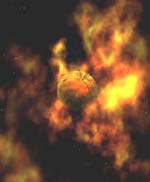
Image credit: NASA
A team of astronomers were lucky enough to observe the rare event of a neutron star turning into a magnetic object called a magnetar. Ten magnetars have been seen to date, but this object, a transient magnetar, is brand new. A normal neutron star is the rapidly spinning remnant of a star that went supernova; they typically possess a very strong magnetic field. A magnetar is similar, but it has a magnetic field up to 1,000 times as strong as a neutron star. This new discovery could indicate that magnetars are more common in the Universe than previously thought.
In a lucky observation, scientists say they have discovered a neutron star in the act of changing into a rare class of extremely magnetic objects called magnetars. No such event has been witnessed definitively until now. This discovery marks only the tenth confirmed magnetar ever found and the first transient magnetar.
The transient nature of this object, discovered in July 2003 with NASA’s Rossi X-ray Timing Explorer, may ultimately fill in important gaps in neutron star evolution. Dr. Alaa Ibrahim of George Washington University and NASA Goddard Space Flight Center in Greenbelt, Md., presents this result today at the meeting of the American Astronomical Society in Atlanta.
A neutron star is the core remains of a star at least eight times more massive than the Sun that exploded in a supernova event. Neutron stars are highly compact, highly magnetic, fast-spinning objects with about a Sun’s worth of mass compressed into a sphere roughly ten miles in diameter.
A magnetar is up to a thousand times more magnetic than ordinary neutron stars. At a hundred trillion (10^14) Gauss, they are so magnetic that they could strip a credit card clean at a distance of 100,000 miles. The Earth’s magnetic field, in comparison, is about 0.5 Gauss, and a strong refrigerator magnet is about 100 Gauss. Magnetars are brighter in X rays than they are in visible light, and they are the only stars known that shine predominantly by magnetic power.
The observation presented today supports the theory that some neutron stars are born with these ultrahigh magnetic fields, but they may be at first too dim to see and measure. In time, however, these magnetic fields act to slow the neutron star’s spin. This act of slowing releases energy, making the star brighter. Additional disturbances in the star’s magnetic field and crust can make it brighter yet, leading to the measurement of its magnetic field. The newly discovered star, dim as recent as a year ago, is named XTE J1810-197.
“The discovery of this source came courtesy of another magnetar that we were monitoring, named SGR 1806-20,” said Ibrahim. He and his colleagues detected XTE J1810-197 with the Rossi Explorer about a degree to the northeast of SGR 1806-20, within the Milky Way galaxy about 15,000 light years away in the constellation Sagittarius.
Scientists pinpointed the location of the source with NASA’s Chandra X-ray Observatory, which provides more accurate positioning than Rossi. Checking archive data from the Rossi Explorer, Dr. Craig Markwardt of NASA Goddard estimated that XTE J1810-197 became active (that is, 100 times brighter than before) around January 2003. Looking back even further with archived data from ASCA and ROSAT, two decommissioned international satellites, the team could spot XTE J1810-197 as a very dim, isolated neutron star as early as 1990. Thus, the history of XTE J1810-197 emerged.
The inactive state of XTE J1810-197, Ibrahim said, was similar to that of other puzzling objects called Compact Central Objects (CCOs) and Dim Isolated Neutron Stars (DINSs). These objects are thought to be neutron stars created in the hearts of star explosions, and some still reside there, but they are too dim to study in detail.
One mark of a neutron star is its magnetic field. But to measure this, scientists need to know the neutron star’s spin period and the rate that it is slowing down, called the “spin down”. When XTE J1810-197 lit up, the team could measure its spin (1 revolution per 5 seconds, typical of magnetars), its spin down, and thus its magnetic field strength (300 trillion Gauss).
In the alphabet soup of neutron stars, there are also Anomalous X-ray Pulsars (AXPs) and Soft Gamma-ray Repeaters (SGRs). Both of these are now considered to be the same kind of objects, magnetars; and another presentation at today’s meeting by Dr. Peter Woods et al. supports this connection. These objects periodically but unpredictably erupt with X-ray and gamma-ray light. CCOs and DINSs appear not to have a similar active state.
Although the concept is still speculative, an evolutionary pattern may be emerging, Ibrahim said. The same neutron star, endowed with an ultrahigh magnetic field, may pass through each of these four phases during its lifetime. The proper order, however, remains unclear. “Discussion of such a pattern has surfaced in the scientific community in recent years, and XTE J1810-197’s transient nature provides the first tangible evidence in favor of such a kinship,” Ibrahim said. “With a few more examples of stars showing a similar trend, a magnetar family tree may emerge.”
“The observation implies that magnetars could be more common than what is seen but exist in a prolonged dim state,” said team member Dr. Jean Swank of NASA Goddard.
“Magnetars seem now to be in a perpetual carnival mode; SGRs are turning into AXPs and AXPs can start behaving like SGRs anytime and without warning,” said team member Dr. Chryssa Kouveliotou of NASA Marshall, who is receiving the Rossi Award at the AAS meeting for her work on magnetars. “What started with a few odd sources, may soon be proven to encompass a huge number of objects in our Galaxy.”
Additional supporting data came from the Interplanetary Network and the Russian-Turkish Optical Telescope. Ibrahim’s colleagues on this observation also include Dr. William Parke of George Washington University; Drs. Scott Ransom, Mallory Roberts and Vicky Kaspi of McGill University; Dr. Peter Woods of NASA Marshall; Dr. Samar Safi-Harb of the University of Manitoba; Dr. Solen Balman of the Middle East Technical University in Ankara; and Dr. Kevin Hurley of University of California at Berkeley. Drs. Eric Gotthelf and Jules Halpern of Columbia University provided important data from Chandra.
Original Source: NASA News Release
Planet is Causing Solar Storms
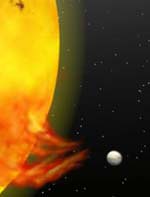
Image credit: UBC
Astronomers from the University of British Columbia have discovered that a Jupiter-sized planet is interacting with its star, causing magnetic storms. The sun-like star, HD170049, is located approximately 90 light-years away in the constellation of Sagittarius, and was found to have a planet back in 2000 by another group of astronomers. These new observations using the Canada-France-Hawaii telescope on Mauna Kea have tracked a bright spot that goes around the star keeping pace with its planet – it’s been doing this for more than 100 orbits of the planet.
Canadian astronomers announced today the first evidence of a magnetic field on a planet outside of our solar system which is also the first observation of a planet heating its star. The report was presented this morning by Ph.D. candidate Evgenya Shkolnik, Dr. Gordon Walker, both of the University of British Columbia, Vancouver, BC and Dr. David Bohlender of the National Research Council of Canada / Herzberg Institute for Astrophysics, Victoria, BC at the meeting of the American Astronomical Society in Atlanta, Georgia. The result may offer clues about the structure and formation of the giant planet.
The trio observed the sun-like star HD179949 with the 3.6-meter (142-in) Canada-France-Hawaii Telescope atop Mauna Kea, Hawaii (a 14,000-ft. dormant volcano) using its high-resolution spectrograph called Gecko. HD179949 is 90 light years away in the direction of the southern constellation of Sagittarius (the Archer) but it is too faint to be seen without a telescope. It was first reported to have a close-in planet by Tinney, Butler, Marcy and others in the first results of the Anglo-Australian planet search in 2000. The planet is at least 270 times more massive than the Earth, almost as big as Jupiter, and orbits the star every 3.093 days at 350,000 mph. Such tightly orbiting ?roasters? or ?hot jupiters? make up 20% of all known extrasolar planets.
The star?s chromosphere, a thin, hot layer just above the visible photosphere, was observed in the ultraviolet light emitted by singly-ionized Calcium atoms. Giant magnetic storms produce hot spots which are visible as bright patches in this light. Such a persistent hotspot is observed on HD 179949 keeping pace with the planet in its 3-day orbit for more than a year (or 100 orbits)! The hotspot appears to be moving across the surface of the star slightly ahead of, but keeping pace with the planet. Most evidence suggests the star is rotating too slowly to carry the spot around so quickly.
The best explanation for this traveling hot spot is an interaction between the planet?s magnetic field and the star?s chromosphere, something predicted by Steve Saar of the Center for Astrophysics and Manfred Cuntz of the University of Texas at Arlington in 2000. If so, this is the first ever glimpse of a magnetic field on a planet outside of our solar system, and may provide clues about the planet?s structure and formation.
?If we are indeed witnessing the entanglement of the magnetic field of a star with that of its planet it gives us an entirely new insight into the nature of closely bound planets.? — Dr. Gordon Walker
Obviously, more observations are needed to test if the magnetic interaction is a transient event or something longer lasting. Also, observations from the 8-meter Gemini-South Telescope in Chile of this stellar system are underway in the infrared light emitted by Helium which would map hotspots at higher levels of the chromosphere.
This work was supported by the Canadian Natural Science and Engineering Research Council and the National Research Council of Canada.
Original Source: UBC News Release
Spirit’s Airbags will Get Another Tug
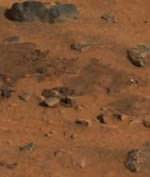
Image credit: NASA/JPL
Engineers have found that Spirit’s landing on Mars didn’t go quite as smoothly as they’d hoped. It turns out that the protective airbags haven’t fully retracted, and could snag the rover’s solar panels as it tries to get off the landing platform. Their current plan is to lift up the landing flap, try to pull the airbag back in, and then drop the flap again. The rover sent home the first high-resolution stereo images from the surface of Mars, which have provided new details about the rover’s environment – an enticing target is a low hill approximately 2 km away which could show layers of sediment.
The engineers and scientists for NASA’s Spirit are eager to get the rover off its lander and out exploring the terrain that Spirit’s pictures are revealing, but caution comes first.
An added “lift and tuck” to get deflated airbag material out of the way extends the number of activities Spirit needs to finish before it can get its wheels onto martian ground.
“We’ll lift up the left petal of the lander, retract the airbag, then let the petal back down,” said Art Thompson, rover tactical uplink lead at NASA’s Jet Propulsion Laboratory, Pasadena, Calif. This and other added activities have pushed the earliest scenario for roll-off to Jan. 14, and it could be later.
The first stereo image mosaic from Spirit’s panoramic camera provided new details of the landscape’s shapes, including hills about 2 kilometers (1.2 miles) away that scientists are discussing as a possible drive target for the rover. The rover’s infrared sensing instrument, called the miniature thermal emission spectrometer, has begun returning data about the surroundings, too, indicating that it is in good health. Now, positive health reports are in for all of Spirit’s science instruments.
The rover carried out commands late Tuesday to pull in the cords to its base-petal airbags with three turns of the airbag retraction motor. “We got about a 5 centimeter (2 inch) lowering of the airbag to the left of the front of the lander, which is the one we’re most concerned about,” said JPL’s Arthur Amador, mission manager. “That airbag is still a little too high, and we’re concerned that we might hit it with our solar panel on the way down.”
The rover could also turn to roll off in a different direction, but the maneuver to lift a petal and pull airbags further under it is designed to improve conditions for exiting to the front.
“We have experienced a couple of hiccups, so we’re being very cautious about how we deal with them,” Thompson said. One concern from Sunday and Monday was resolved late Tuesday, when results of testing a motor that moves the high-gain antenna showed no sign of a problem.
“We’re chomping at the bit to get this puppy off the lander,” Thompson said.
Dr. Ray Arvidson of Washington University in St. Louis, Mo., deputy principal investigator for the rover’s science instruments, said the science team gathered in Pasadena has been offering diverse theories for how the landscape surrounding Spirit was shaped, and anticipating ways to test the theories with the rover’s instruments.
“A lake bed is typically flat, with very fine-grain sediments,” Arvidson said. “That’s not what we’re looking at. If these are lake sediments, then they’ve been chewed up by impacts and rocks have been brought in.”
Besides looking forward to exploring away from the lander, the rover teams are looking forward to getting Spirit’s twin Mars Exploration Rover, Opportunity, safely landed on Mars. Atmospheric conditions in the region of Opportunity’s landing site are being monitored from orbit, said Dr. Joy Crisp, project scientist for both rovers. Information about the actual conditions Spirit experienced on its descent through Mars’ atmosphere are being compared with the conditions predicted ahead of time in order to refine the predictions for what Opportunity will experience.
Spirit arrived at Mars Jan. 3 (EST and PST; Jan. 4 Universal Time) after a seven-month journey. Its task is to spend the next three months exploring for clues in rocks and soil about whether the past environment at this part of Mars was ever watery and suitable to sustain life.
Spirit’s twin Mars Exploration Rover, Opportunity, will reach its landing site on the opposite side of Mars on Jan. 25 (EST and Universal Time; Jan. 24 PST) to begin a similar examination of a site on the opposite side of the planet from Gusev Crater.
JPL, a division of the California Institute of Technology in Pasadena, manages the Mars Exploration Rover project for NASA’s Office of Space Science, Washington, D.C. Additional information about the project is available from JPL at http://marsrovers.jpl.nasa.gov and from Cornell University, Ithaca, N.Y., at http://athena.cornell.edu.
Original Source: NASA/JPL News Release
Supernova’s Companion Star Found
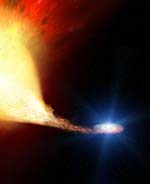
Image credit: ESA
When the second brightest supernova seen in modern times, SN 1993J, blew up several years ago, it did leave a survivor. Using the Hubble Space Telescope, and several ground-based observatories, an international team of astronomers discovered a massive companion star that must have been orbiting the supernova at the time it exploded. This discovery is very important because it will allow astronomers watch what the remnant of SN 1993J does to its companion star. They might even be able to detect a neutron star or black hole forming in real time.
A joint European/University of Hawaii team of astronomers has for the first time observed a stellar ?survivor? to emerge from a double star system involving an exploded supernova.
Supernovae are some of the most significant sources of chemical elements in the Universe, and they are at the heart of our understanding of the evolution of galaxies.
Supernovae are some of the most violent events in the Universe. For many years astronomers have thought that they occur in either solitary massive stars (Type II supernovae) or in a binary system where the companion star plays an important role (Type I supernovae). However no one has been able to observe any such companion star. It has even been speculated that the companion stars might not survive the actual explosion…
The second brightest supernova discovered in modern times, SN 1993J, was found in the beautiful spiral galaxy M81 on 28 March 1993. From archival images of this galaxy taken before the explosion, a red supergiant was identified as the mother star in 1993 – only the second time astronomers have actually seen the progenitor of a supernova explosion (the first was SN 1987A, the supernova that exploded in 1987 in our neighbouring galaxy, the Large Magellanic Cloud).
Initially rather ordinary, SN 1993J began to puzzle astronomers as its ejecta seemed too rich in the chemical element helium and instead of fading normally it showed a bizarre sharp increase in brightness. The astronomers realised that a normal red supergiant alone could not have given rise to such a weird supernova. It was suggested that the red supergiant orbited a companion star that had shredded its outer layers just before the explosion.
Ten years after this cataclysmic event, a European/University of Hawaii team of astronomers has now peered deep into the glowing remnants of SN 1993J using the NASA/ESA Hubble Space Telescope?s Advanced Camera for Surveys (ACS) and the giant Keck telescope on Mauna Kea in Hawaii. They have discovered a massive star exactly at the position of the supernova that is the long sought companion to the supernova progenitor.
This is the first supernova companion star ever to be detected and it represents a triumph for the theoretical models. In addition, this observation allows a detailed investigation of the stellar physics leading to supernova explosions. It is now clear that during the last 250 years before the explosion 10 solar masses of gas were torn violently from the red supergiant by its partner. By observing the companion closely in the coming years it may even be possible to detect a neutron star or black hole emerge from the remnants of the explosion ?in real time?.
Given the paucity of observations of supernova progenitor systems this result, published in Nature on 8 January 2004, is likely to ‘be crucial to understanding how very massive stars explode and why we see such peculiar supernovae’ according to first author Justyn R. Maund from the University of Cambridge, UK.
The team is composed of Stephen J. Smartt and Justyn R. Maund (University of Cambridge, UK), Rolf. P. Kudritzki (University of Hawaii, USA), Philipp Podsiadlowski (University of Oxford, UK) and Gerry F. Gilmore (University of Cambridge, UK).
Stephen Smartt, also from the University of Cambridge, says, ?Supernova explosions are at the heart of our understanding of the evolution of galaxies and the formation of chemical elements in the Universe. It is essential that we know what type of stars produce them.?
For the last ten years astronomers have believed that they could understand the very peculiar behaviour of 1993J by invoking the existence of a binary companion star and now this picture has proved correct.
According to Rolf Kudritzki, from the University of Hawaii, ?The combination of the outstanding spatial resolution of Hubble and the huge light gathering power of the Keck 10- metre telescope in Hawaii has made this fantastic discovery possible.?
Supernovae occur when a star of more than about eight times the mass of the Sun reaches the end of its nuclear fuel reserves and can no longer produce enough energy to keep the star from collapsing under its own immense weight. The core of the star collapses, and the outer layers are ejected in a fast-moving shock wave.
This huge energy release causes the visible supernova we see. While astronomers are convinced that observations will match this theoretical model, they are in the embarrassing position that they have confidently identified only two stars that later exploded as supernovae ? the precursors of supernovae 1987A and 1993J.
There have been more than 2000 supernovae discovered in galaxies beyond the Milky Way and there appear to be about eight distinct sub-classes. However identifying which stars produce which flavours has proved incredibly difficult. This team has now embarked on a parallel project with the Hubble Space Telescope to image a large number of galaxies and then wait patiently for a supernova to explode.
Supernovae appear in spiral galaxies like M81 on average once every 100 years or so. The team, led by Stephen Smartt, hope to increase the numbers of supernova progenitors known from 2 to 20 over the next five years.
Original Source: ESA News Release
Book Review: The Solar System
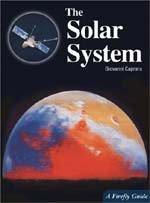
Our solar system is our neighbourhood. It is what supports our life, sets us apart from other regions of space and even protects us from extra-solar visitors. Yet our knowledge of this region is frustratingly incomplete. Not only is the physical space dauntingly large but the time scale of its existence is equally vast. Giovanni Caprara in his book “The Solar System” provides us with an up to date account of what we have observed in our solar system and demonstrates some of the physical processes taking place both now and at earlier times.
Caprara starts by presenting the most accepted methods for solar system formation and he continually returns to this when considering the formation of each of the planets. As interstellar dust and gas are the core building blocks there is a lot of room for variety. Perhaps what is more surprising is the quantity of similarities and patterns that result.
With an extensive chapter for the sun and each planet the reader can both learn specific details as well as make comparative studies. There are descriptions of these bodies’ physical characteristics such as the size, the distance from the Sun and the mass. Where appropriate Caprara discusses the atmosphere and climate. Also he presents distinctive surface features and their causes such as asteroid impacts or plate tectonics. He guesses at the body’s internal structure though except for the Earth and Moon there is no data to provide corroboration. If the planets have their own satellites he describes each individually in much the same manner. What these details readily show is that we really do live in a system with all components inherently linked to one another.
Pleasantly interposed within the text are vignettes that tell the reader how the information was obtained. Usually each vignette has an accompanying pictorial representation whether a drawing by 17’th century astronomers, plates from ground-based observatories or images from space probes. As most of the images are of recent photographs from space probes they add a current feel to the book. What becomes readily apparent is that only with advances to our observational ability will we get advances in our understanding.
There is also a purposeful tie-in with this information to our own benefit on Earth. The process of global warming is evident on Venus. Tidal effects between Io and Jupiter are equally present between the Earth and Moon. Asteroids are present in large numbers and obviously continually strike as seen when Shoemaker-Levy hit Jupiter. And, as seen with other stars, our Sun will eventually change and make life on Earth untenable. Knowing about our neighbourhood isn’t just for cursory interest it can also help with our survival
This book is a good source of information though a more robust list of references would aid those looking for greater detail. Also, there seems to be a few errors either from the original text or the translation. However none of these detract from the text. Further, as this book originates in Italy I was hoping that there would be a distinct European view. Unfortunately none was apparent.
The results of Caprara’s work is a thorough description of our solar system. The reader can easily feel they are travelling with the author as they discover each planet and satellite. They will also quickly become supporters of the scientists who work so hard to add even more to what we know about our neighbourhood. The next big space probe is the United States’ New Horizons mission to Pluto. This is to add to the limited fuzzy pictures which is all we have now. Let’s hope it succeeds.
Learn more from Amazon.com
Review by Mark Mortimer
Lifeless Suns in the Early Universe
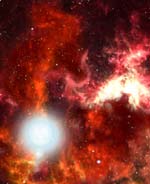
Image credit: Harvard CfA
New calculations by a pair of Harvard astronomers predict that the first “Sun-like” stars in the Universe were alone; devoid of planets or life. The very first generation of stars was hot and massive; they lived hard and died young. After they exploded as supernovae and seeded the Universe with heavier materials, other stars formed in stellar nurseries. The next generation of stars was probably similar in mass and composition to our own Sun, but there weren’t enough minerals to create rocky planets like the Earth. It took a succession of supernovae before there was enough heavy material that planets could form – probably 500 million to 2 billion years after the Big Bang.
To most people, the phrase “Sun-like star” calls to mind images of a friendly, warm yellow star accompanied by a retinue of planets possibly capable of nurturing life. But new calculations by Harvard astronomers Volker Bromm and Abraham Loeb (Harvard-Smithsonian Center for Astrophysics), which were announced today at the 203rd meeting of the American Astronomical Society in Atlanta, show that the first Sun-like stars were lonely orbs moving through a universe devoid of planets or life.
“The window for life opened sometime between 500 million and 2 billion years after the Big Bang” says Loeb. “Billions of years ago, the first low-mass stars were lonely places. The reason for that youthful solitude is embedded in the history of our universe.”
In The Beginning
The very first generation of stars were not at all like our Sun. They were white-hot, massive stars that were very short-lived. Burning for only a few million years, they collapsed and exploded as brilliant supernovae. Those very first stars began the seeding process in the universe, spreading vital elements like carbon and oxygen, which served as planetary building blocks.
“Previously, with Lars Hernquist and Naoki Yoshida (also at the CfA), I have simulated those first supernova explosions to calculate their evolution and how much heavy elements (elements heavier than hydrogen or helium) they produced,” says Bromm. “Now, in this work, Avi Loeb and I have determined that a single first-generation supernova could produce enough heavy elements to enable the first Sun-like stars to form.”
Bromm and Loeb showed that many second-generation stars had sizes, masses, and hence temperatures similar to our Sun. Those properties resulted from the cooling influence of carbon and oxygen when the stars formed. Even elemental abundances as low as one-ten thousandth those found in the Sun proved sufficient to allow smaller, low-mass stars like our Sun to be born.
Yet those same low abundances prohibited rocky planets from forming around those first Sun-like stars due to a lack of raw materials. Only as further generations of stars lived, died, and enriched the interstellar medium with heavy elements did the birth of planets, and life itself, become possible.
“Life is a recent phenomenon,” Loeb states unequivocally. “We know that it took many supernova explosions to make all the heavy elements we find here on Earth and in our Sun and our bodies.”
Recent observational evidence corroborates their finding. Studies of known extrasolar planets have found a strong correlation between the presence of planets and the abundance of heavy elements (“metals”) in their stars. That is, a star with higher metallicity and more heavy elements is more likely to possess planets. Conversely, the lower a star’s metallicity, the less likely it is to have planets.
“We’re now just beginning to investigate the metallicity threshold for planet formation, so it’s hard to say when exactly the window for life opened. But clearly, we’re fortunate that the metallicity of the matter that birthed our solar system was high enough for the Earth to form,” says Bromm. “We owe our existence in a very direct way to all the stars whose life and death preceded the formation of our Sun. And this process began right after the Big Bang with the very first stars. As the universe evolved, it progressively seeded itself with all the heavy elements necessary for planets and life to form. Thus, the evolution of the universe was a step-by-step process that resulted in a stable G-2 star capable of sustaining life. A star we call the Sun.”
Original Source: Harvard CfA News Release
Spirit Landing Site Named for Columbia Crew
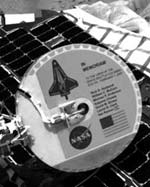
Image credit: NASA/JPL
NASA administrator Sean O’Keefe announced on Tuesday that they plan to name the Spirit landing site in honour of the Columbia astronauts who lost their lives nearly a year ago. The place where Spirit landed in Gusev Crater will be called the Columbia Memorial Station. One image sent back by the rover shows a memorial plaque attached to Spirit’s high-gain antenna – the plaque is aluminum and approximately 15 cm across.
NASA Administrator Sean O’Keefe today announced plans to name the landing site of the Mars Spirit Rover in honor of the astronauts who died in the tragic accident of the Space Shuttle Columbia in February. The area in the vast flatland of the Gusev Crater where Spirit landed this weekend will be called the Columbia Memorial Station.
Since its historic landing, Spirit has been sending extraordinary images of its new surroundings on the red planet over the past few days. Among them, an image of a memorial plaque placed on the spacecraft to Columbia’s astronauts and the STS-107 mission.
The plaque is mounted on the back of Spirit’s high-gain antenna, a disc-shaped tool used for communicating directly with Earth. The plaque is aluminum and approximately six inches in diameter. The memorial plaque was attached March 28, 2003, at the Payload Hazardous Servicing Facility at NASA’s Kennedy Space Center, Fla. Chris Voorhees and Peter Illsley, Mars Exploration Rover engineers at NASA’s Jet Propulsion Laboratory, Pasadena, Calif., designed the plaque.
“During this time of great joy for NASA, the Mars Exploration Rover team and the entire NASA family paused to remember our lost colleagues from the Columbia mission. To venture into space, into the unknown, is a calling heard by the bravest, most dedicated individuals,” said NASA Administrator Sean O’Keefe. “As team members gazed at Mars through Spirit’s eyes, the Columbia memorial appeared in images returned to Earth, a fitting tribute to their own spirit and dedication. Spirit carries the dream of exploration the brave astronauts of Columbia held in their hearts.”
Spirit successfully landed on Mars Jan. 3. It will spend the next three months exploring the barren landscape to determine if Mars was ever watery and suitable to sustain life. Spirit’s twin, Opportunity, will reach Mars on Jan. 25 to begin a similar examination of a site on the opposite side of the planet.
Original Source: NASA News Release
SMART-1 Gets Out of the Radiation Belts
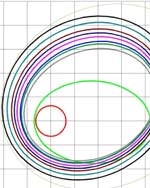
Image credit: ESA
The European Space Agency’s SMART-1 spacecraft has completed its 176th orbit around the Earth, finally reaching the outer limits of our planet’s Van Allen radiation belts. After weeks in the intense radiation, it looks like everything on SMART-1 is functioning normally. The spacecraft has fired its ion thruster for a total of 1,500 hours and only consumed 24 kg of Xenon fuel. SMART-1 is taking the slow road to the Moon, where it will map the surface and search for deposits of ice.
The spacecraft is now in its 176th orbit, in good status and with all functions performing nominally. The first mission target, namely to exit the most dangerous part of the radiation belts, has been achieved! The pericentre altitude (the closest distance of the spacecraft from the centre of the Earth) will reach the prelaunch target of 20 000 km on 7 January 2004.
Between 23 December 2003 and 2 January 2004, the thruster fired continuously for a record duration of more than 240 hours. This is likely to remain the record for some time because later this week SMART-1 will change from a continuous thrust strategy to a more orbitally efficient thrust arcing.
The total cumulated thrust so far of more than 1500 hours, consuming 24 kg of Xenon, has provided a velocity increment of about 1070 ms-1 (equivalent to 3850 km per hour). The electric propulsion engine’s performance, periodically monitored by means of the telemetry data transmitted by the spacecraft and by radio-tracking by the ground stations, continues to show a small over performance in thrust: varying from 1.1% to 1.5% over the last week.
The degradation of the electrical power produced by the solar arrays has now ceased. The power available has remained virtually constant since November 2003.
The communication, data handling, on-board software and thermal subsystems have been performing well in this period.
Original Source: ESA News Release
